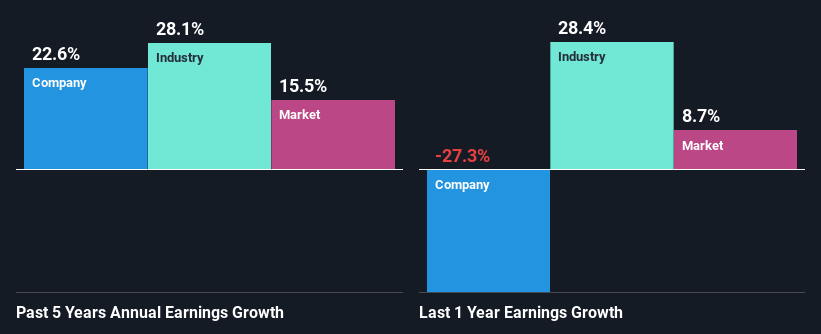Are Robust Financials Driving The Recent Rally In NVIDIA Corporation's (NASDAQ:NVDA) Stock?
NVIDIA (NASDAQ:NVDA) has had a great run on the share market with its stock up by a significant 40% over the last month. Since the market usually pay for a company’s long-term fundamentals, we decided to study the company’s key performance indicators to see if they could be influencing the market. In this article, we decided to focus on NVIDIA's ROE.
ROE or return on equity is a useful tool to assess how effectively a company can generate returns on the investment it received from its shareholders. In other words, it is a profitability ratio which measures the rate of return on the capital provided by the company's shareholders.
View our latest analysis for NVIDIA
How To Calculate Return On Equity?
The formula for return on equity is:
Return on Equity = Net Profit (from continuing operations) ÷ Shareholders' Equity
So, based on the above formula, the ROE for NVIDIA is:
28% = US$6.0b ÷ US$21b (Based on the trailing twelve months to October 2022).
The 'return' refers to a company's earnings over the last year. That means that for every $1 worth of shareholders' equity, the company generated $0.28 in profit.
Why Is ROE Important For Earnings Growth?
So far, we've learned that ROE is a measure of a company's profitability. Based on how much of its profits the company chooses to reinvest or "retain", we are then able to evaluate a company's future ability to generate profits. Assuming everything else remains unchanged, the higher the ROE and profit retention, the higher the growth rate of a company compared to companies that don't necessarily bear these characteristics.
NVIDIA's Earnings Growth And 28% ROE
To begin with, NVIDIA has a pretty high ROE which is interesting. Secondly, even when compared to the industry average of 18% the company's ROE is quite impressive. Under the circumstances, NVIDIA's considerable five year net income growth of 23% was to be expected.
Next, on comparing NVIDIA's net income growth with the industry, we found that the company's reported growth is similar to the industry average growth rate of 28% in the same period.
Earnings growth is a huge factor in stock valuation. The investor should try to establish if the expected growth or decline in earnings, whichever the case may be, is priced in. This then helps them determine if the stock is placed for a bright or bleak future. One good indicator of expected earnings growth is the P/E ratio which determines the price the market is willing to pay for a stock based on its earnings prospects. So, you may want to check if NVIDIA is trading on a high P/E or a low P/E, relative to its industry.
Is NVIDIA Efficiently Re-investing Its Profits?
NVIDIA has a really low three-year median payout ratio of 7.1%, meaning that it has the remaining 93% left over to reinvest into its business. So it looks like NVIDIA is reinvesting profits heavily to grow its business, which shows in its earnings growth.
Additionally, NVIDIA has paid dividends over a period of at least ten years which means that the company is pretty serious about sharing its profits with shareholders. Existing analyst estimates suggest that the company's future payout ratio is expected to drop to 2.5% over the next three years. As a result, the expected drop in NVIDIA's payout ratio explains the anticipated rise in the company's future ROE to 53%, over the same period.
Conclusion
On the whole, we feel that NVIDIA's performance has been quite good. Particularly, we like that the company is reinvesting heavily into its business, and at a high rate of return. Unsurprisingly, this has led to an impressive earnings growth. We also studied the latest analyst forecasts and found that the company's earnings growth is expected be similar to its current growth rate. Are these analysts expectations based on the broad expectations for the industry, or on the company's fundamentals? Click here to be taken to our analyst's forecasts page for the company.
Have feedback on this article? Concerned about the content? Get in touch with us directly. Alternatively, email editorial-team (at) simplywallst.com.
This article by Simply Wall St is general in nature. We provide commentary based on historical data and analyst forecasts only using an unbiased methodology and our articles are not intended to be financial advice. It does not constitute a recommendation to buy or sell any stock, and does not take account of your objectives, or your financial situation. We aim to bring you long-term focused analysis driven by fundamental data. Note that our analysis may not factor in the latest price-sensitive company announcements or qualitative material. Simply Wall St has no position in any stocks mentioned.
Join A Paid User Research Session
You’ll receive a US$30 Amazon Gift card for 1 hour of your time while helping us build better investing tools for the individual investors like yourself. Sign up here

 Yahoo Finance
Yahoo Finance 
